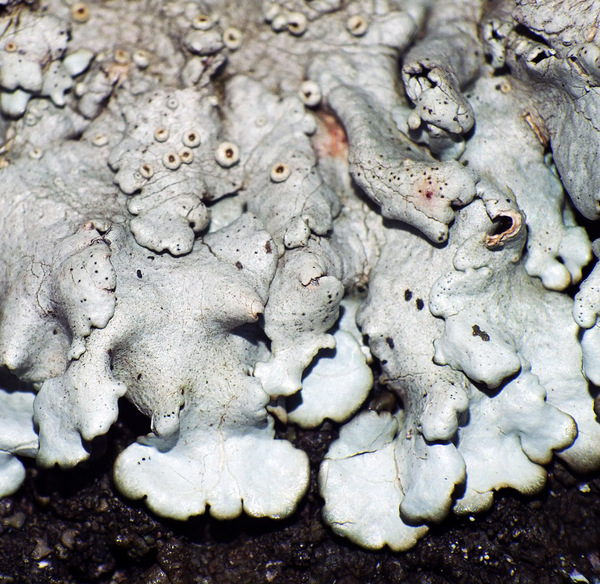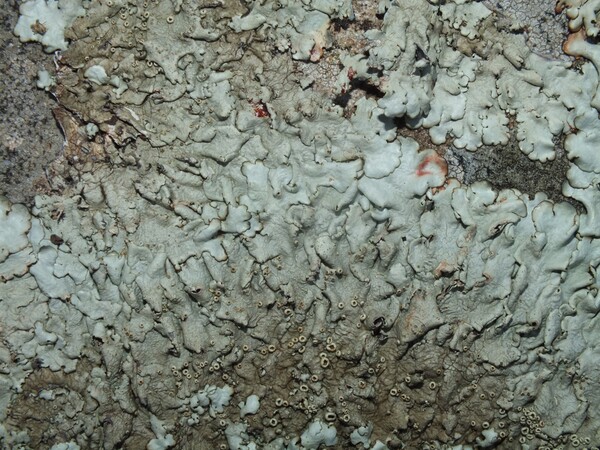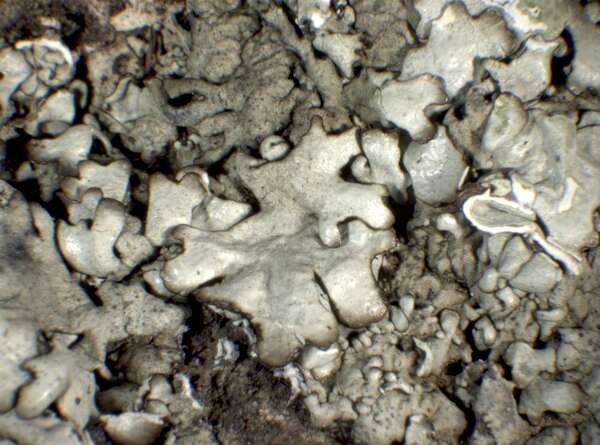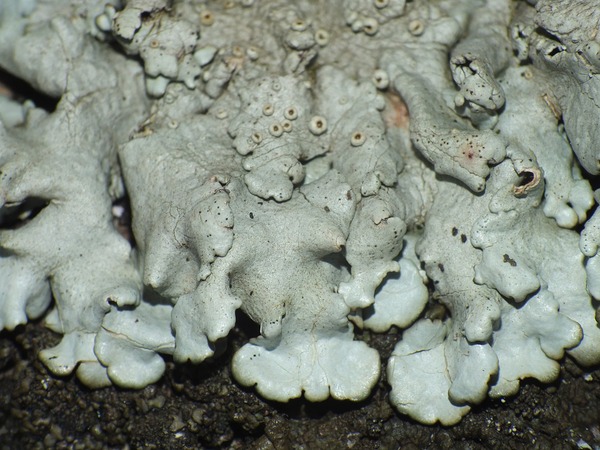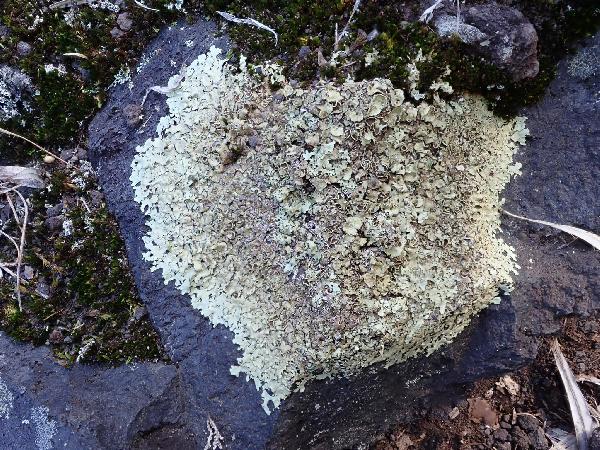Xanthoparmelia sublaevis (Cout.) Hale
Mycotaxon, 33: 406, 1988. Basionym: Parmelia sublaevis Cout. - Lich. Lusit. Cat.: 71, 1916.
Synonyms: Imbricaria conspersa var. hypoclista (Nyl.) Arnold; Parmelia conspersa var. hypoclista Nyl.
Distribution: N - TAA (Giordani & al. 2002b, Nascimbene 2006c), VA (Matteucci & al. 2015c, 2015d), Lig (Giordani & al. 2009, 2025). C - Tosc (Giordani & al. 2009), Sar (Giordani & al. 2002b).
Description: Thallus foliose, heteromerous, dorsiventral, adnate, forming up to 20 cm wide, irregular rosettes, the lobes flat to slightly convex, contiguous to imbricate, 0.5-3 mm wide. Upper surface yellowish-green, smooth, shiny, epruinose and emaculate; lower surface pale to dark brown, with mostly simple rhizines. Upper cortex paraplectenchymatous, of anticlinally arranged hyphae or of isodiametrical cells, with a pored epicortex, the cell walls with Xanthoparmelia-type lichenan; medulla white; lower cortex paraplectenchymatous. Apothecia frequent, lecanorine, substipitate, 2-8 mm across, with a brown disc and a smooth thalline margin. Epithecium brown; hymenium and hypothecium colourless; paraphyses simple; hypothecium colourless. Asci 8-spored, clavate, the K/I+ blue tholus penetrated by a faintly amyloid apical cushion with parallel or diverging flanks, the wall K/I-, surrounded by a K/I+ blue outer layer, Lecanora-type. Ascospores 1-celled, hyaline, ellipsoid, 9-10 x 5-6 µm. Pycnidia common, black, immersed. Conidia weakly dumbell-shaped, 5-6 x 0.5-1 µm. Spot tests: upper cortex K-, C-, KC- or KC+ pale yellow, P-; medulla K+ yellow turning deep red, C-, KC-, P+ orange. Chemistry: upper cortex with usnic acid; medulla with salazinic and consalazinic acids. Note: on siliceous rocks wetted by rain, hitherto known from the Mediterranean Region and the dry-warm Alpine valleys
Growth form: Foliose, broad lobed
Substrata: rocks
Photobiont: green algae other than Trentepohlia
Reproductive strategy: mainly sexual
Commonnes-rarity: (info)
Alpine belt: absent
Subalpine belt: absent
Oromediterranean belt: absent
Montane belt: absent
Submediterranean belt: extremely rare
Padanian area: absent
Humid submediterranean belt: absent
Humid mediterranean belt: extremely rare
Dry mediterranean belt: very rare
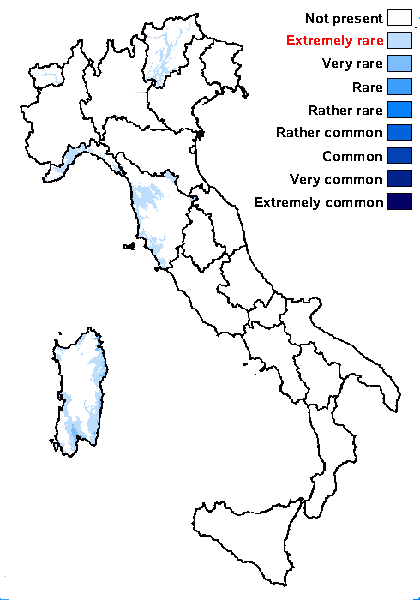
Predictive model
Herbarium samples


P.L. Nimis; Owner: Department of Life Sciences, University of Trieste
Herbarium: GE
2002/02/13
specimen from Sardinia, det. J. Elix
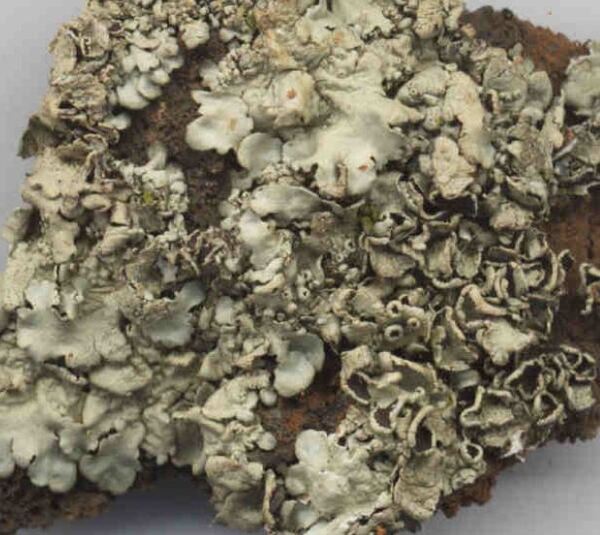

Felix Schumm – CC BY-SA 4.0
Image from: F. Schumm (2008) - Flechten Madeiras, der Kanaren und Azoren. Beck, OHG - ISBN: 978-3-00-023700-3
Growth form: Foliose, broad lobed
Substrata: rocks
Photobiont: green algae other than Trentepohlia
Reproductive strategy: mainly sexual
Commonnes-rarity: (info)
Alpine belt: absent
Subalpine belt: absent
Oromediterranean belt: absent
Montane belt: absent
Submediterranean belt: extremely rare
Padanian area: absent
Humid submediterranean belt: absent
Humid mediterranean belt: extremely rare
Dry mediterranean belt: very rare

Predictive model
| Herbarium samples |


P.L. Nimis; Owner: Department of Life Sciences, University of Trieste
Herbarium: GE
2002/02/13
specimen from Sardinia, det. J. Elix


 INDEX FUNGORUM
INDEX FUNGORUM
 GBIF
GBIF
 DOLICHENS
DOLICHENS
